📞+86 153 7530 2641 📧 hongjing.Wang@feichuncables.com
What's the Difference Between Water-Resistant, Waterproof, and Watertight Cables in Industrial Applications?
Confused about the terms water-resistant, waterproof, and watertight cables? Learn how these cable designs differ in construction, protection level, and application—especially in harsh environments like ports, marine, and underground installations.
hongjing.Wang@Feichun
7/14/2025
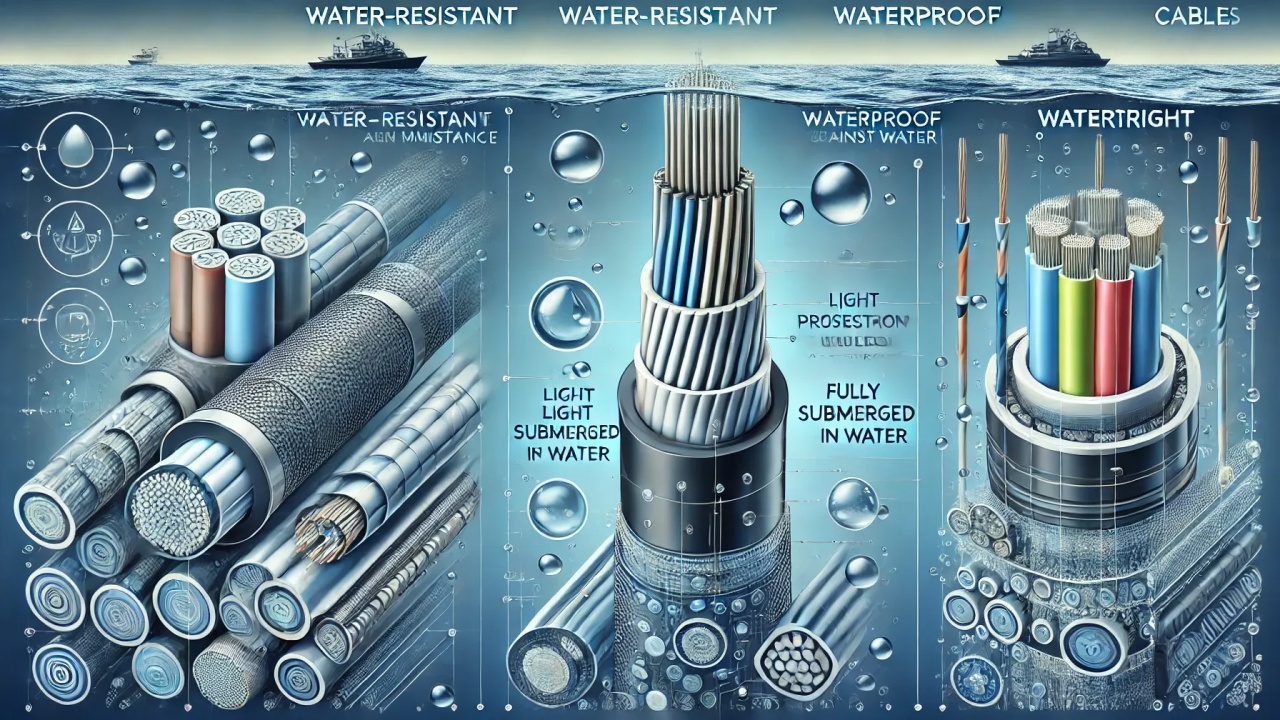

Introduction: Why Water Ingress Protection Matters in Cable Design
Water ingress represents one of the most significant threats to electrical systems in industrial environments. From bustling ports where saltwater spray constantly batters equipment to underground installations where moisture seepage is inevitable, cable water protection has become a critical consideration for engineers and facility managers worldwide. The consequences of inadequate protection extend far beyond simple equipment failure—they encompass safety risks, operational downtime, and substantial financial losses.
Understanding the distinctions between water-resistant, waterproof, and watertight cable designs is essential for selecting the appropriate solution for specific environmental challenges. Each protection level offers different capabilities and is engineered for distinct application scenarios. A cable design for wet environments must account for factors such as exposure duration, water pressure, chemical composition, and temperature fluctuations.
In marine applications, coastal data transmission systems, and port crane operations, the wrong cable choice can result in catastrophic system failures. Similarly, in underground conduit installations or VFD motor applications, inadequate water protection can lead to short circuits, ground faults, and equipment damage. This comprehensive guide explores the technical differences between these protection levels and provides practical guidance for making informed decisions in challenging industrial environments.
What is a Water-Resistant Cable?
Water-resistant cables represent the most basic level of moisture protection, designed to withstand light exposure to water without compromising electrical performance. These cables are engineered to protect against moisture and light splashes but are not intended for direct water immersion or continuous wet conditions. The protection primarily focuses on preventing water penetration through the outer jacket under normal environmental conditions.
The construction of water-resistant cable systems typically employs materials such as PVC (polyvinyl chloride), polyolefin compounds, or thermoplastic rubber for the outer jacket. These materials provide a barrier against casual moisture exposure while maintaining flexibility and durability. The jacket thickness and material composition are carefully balanced to offer adequate protection without excessive weight or cost.
Water-resistant cable construction incorporates several design elements that enhance moisture protection. The conductor insulation is typically rated for damp locations, and the overall cable assembly includes moisture-resistant filling compounds between conductors. However, these cables lack the sophisticated water-blocking technologies found in higher protection levels.
Splash-resistant cables for indoor use are commonly found in control panels, switchgear installations, and other protected environments where occasional moisture exposure may occur. These applications include industrial control rooms, electrical enclosures with potential condensation issues, and areas where cleaning procedures might expose cables to water spray. The protection level is sufficient for environments where water exposure is incidental rather than continuous.
Industrial facilities often utilize water-resistant cables in areas such as motor control centers, instrumentation panels, and lighting circuits where environmental protection is necessary but full waterproofing is not economically justified. These cables provide reliable performance in applications where proper installation practices and environmental controls minimize direct water exposure.
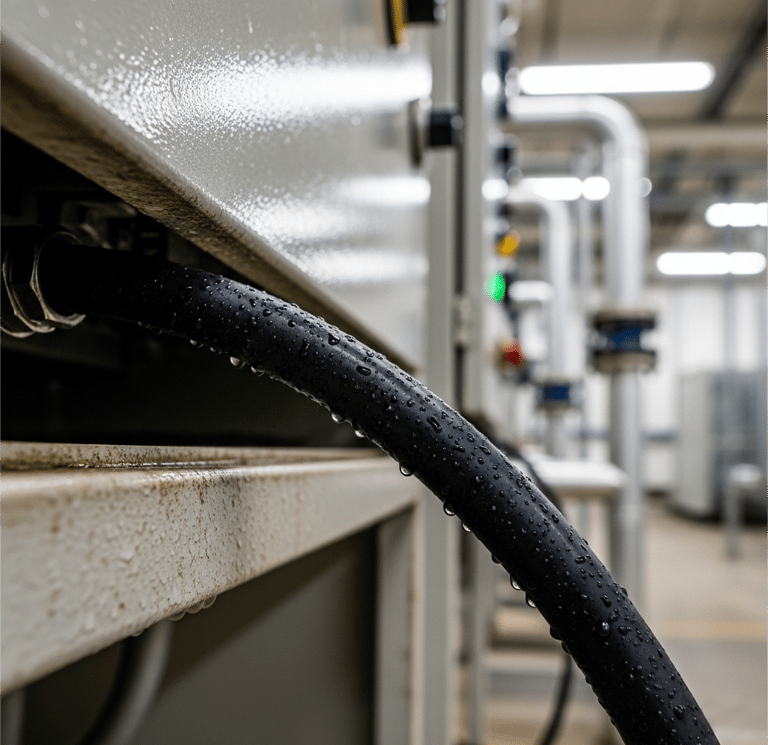

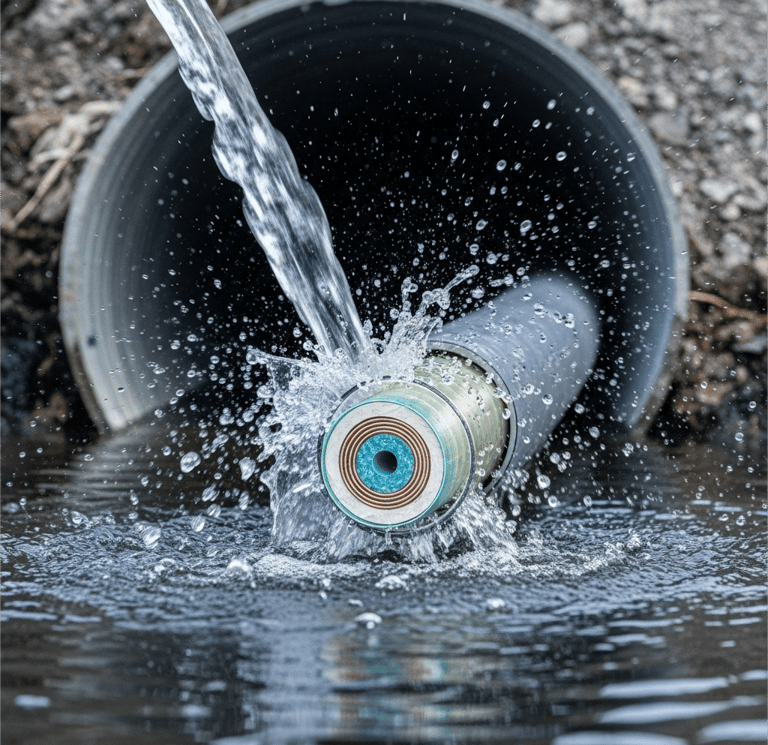

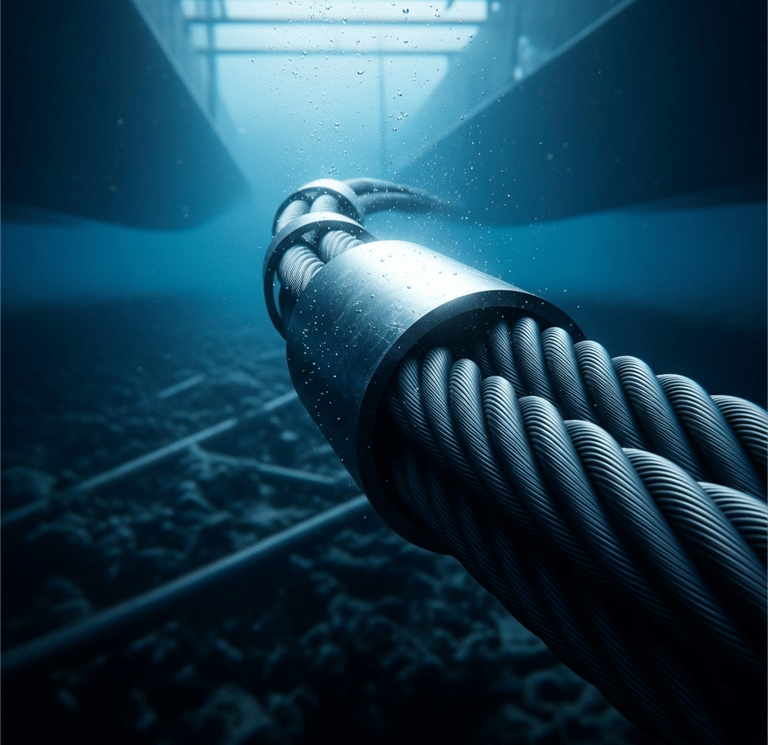

Understanding Watertight Cables: The Highest Protection Level
Watertight cables represent the pinnacle of water ingress protection, designed to withstand continuous immersion and high-pressure water exposure without compromising electrical performance. These cables are engineered for the most demanding environments where water exposure is constant and severe.
The construction of watertight cables incorporates advanced materials and design techniques that create multiple barriers against water penetration. The conductor insulation utilizes specialized polymers that maintain electrical properties even under continuous moisture exposure. Advanced water-blocking technologies, including gel-filled cores and superabsorbent tape systems, create redundant protection layers.
Watertight marine cables must comply with stringent standards for saltwater exposure, pressure resistance, and temperature cycling. These cables incorporate corrosion-resistant materials and specialized conductor treatments that prevent galvanic corrosion in marine environments. The jacket materials are selected for resistance to UV exposure, saltwater, and marine organisms.
Oil-resistant and watertight crane cables represent a specialized category designed for port and offshore applications. These cables must withstand not only water immersion but also exposure to petroleum products, hydraulic fluids, and other industrial chemicals. The construction includes specialized elastomeric compounds that resist both water penetration and chemical degradation.
IP68 watertight cable protection represents the highest standard for continuous submersion resistance. These cables can operate underwater indefinitely without water penetration, making them suitable for permanently submerged applications. The testing requirements include long-term submersion under pressure with electrical performance verification.
Applications for watertight cables include underwater robotics, offshore oil platforms, submarine cable systems, and permanent marine installations. These environments demand the highest level of protection due to continuous water exposure, pressure variations, and harsh chemical conditions.
Testing Standards for Water Ingress Protection
The evaluation of cable water protection relies on comprehensive testing standards that ensure consistent performance across different manufacturers and applications. These standards define specific test procedures, performance criteria, and certification requirements that enable engineers to make informed decisions about cable selection.
Cable IP rating standards provide a systematic approach to classifying water ingress protection. The International Electrotechnical Commission (IEC 60529) standard defines IP ratings that specify protection levels against both solid particles and water ingress. IP67 ratings indicate protection against temporary submersion, while IP68 ratings ensure continuous submersion capability.
IEEE standards provide additional specifications for cable water resistance, particularly for power and communication applications. These standards define testing procedures that simulate real-world conditions, including pressure cycling, temperature variation, and long-term exposure effects.
Waterproof cable compliance with IEC and UL standards ensures that cables meet recognized international safety and performance requirements. UL 1581 provides specific testing procedures for cable jacket integrity, water absorption, and electrical performance under wet conditions. These standards include aging tests that evaluate long-term performance degradation.
Testing procedures involve submersion tests under controlled conditions, pressure cycle testing to simulate depth variations, and electrical performance verification during and after water exposure. The testing includes measurement of insulation resistance, conductor resistance, and signal integrity parameters.
Certification processes require independent laboratory verification of cable performance against established standards. This third-party testing ensures that manufacturer claims are validated through rigorous testing protocols that simulate actual operating conditions.
Cable Design Features That Prevent Water Penetration
The effectiveness of water protection in cables depends on sophisticated design features that create multiple barriers against moisture ingress. These technologies work together to provide comprehensive protection appropriate for the intended application environment.
Water-blocking tape systems utilize superabsorbent polymers that expand when exposed to moisture, creating physical barriers that prevent water advancement along the cable length. These tapes are strategically placed between cable layers to provide maximum protection with minimal impact on cable flexibility.
Gel-filled watertight power cables employ specialized filling compounds that create a continuous moisture barrier throughout the cable interior. The gel material flows around conductors and fills void spaces, preventing water migration even if the outer jacket is compromised. This technology provides excellent protection for both power and control applications.
Double jacket waterproof cable construction incorporates an inner jacket that protects the conductors and an outer jacket that provides environmental protection. This redundant design ensures that minor damage to the outer jacket does not compromise the cable's electrical integrity.
Dry-blocking compounds offer an alternative to gel-filled systems, providing water protection without the mess and handling concerns associated with gel materials. These compounds swell when exposed to moisture but remain solid under normal conditions, making cable installation and maintenance easier.
Sealed jacket structures incorporate specialized sealing technologies at cable terminations and joints. These systems prevent water ingress at connection points, which represent the most vulnerable areas in cable installations.
Application-Specific Selection: How to Choose the Right Protection Level
Selecting the appropriate water protection level requires careful consideration of environmental conditions, operational requirements, and economic factors. The decision process should evaluate both immediate needs and long-term performance expectations.
Cable selection for ports requires the highest protection levels due to constant saltwater exposure, mechanical stress, and harsh operating conditions. Watertight crane cables must withstand not only water immersion but also dynamic loading, abrasion, and chemical exposure. The economic consequences of cable failure in port operations justify the investment in premium protection levels.
Waterproof cable for underground conduit applications represents a balanced approach where temporary water exposure is expected but continuous immersion is unlikely. These installations benefit from waterproof protection while avoiding the higher costs associated with watertight designs. The selection should consider groundwater conditions, conduit sealing quality, and maintenance accessibility.
Indoor electrical cabinet applications may require only water-resistant protection where moisture exposure is limited to condensation or occasional cleaning procedures. The controlled environment and protective enclosures reduce the need for higher protection levels, allowing for more economical cable selection.
Marine and offshore applications demand watertight protection due to constant water exposure, pressure variations, and limited accessibility for maintenance. The harsh operating environment and safety considerations justify the investment in the highest protection levels available.
Industrial process environments require careful evaluation of specific exposure conditions. Chemical plants, food processing facilities, and pharmaceutical manufacturing may require specialized protection against both water and chemical exposure.
Conclusion: Matching Cable Design to Environmental Risk
The selection of appropriate water protection for cables requires a comprehensive understanding of environmental conditions, performance requirements, and economic considerations. Each protection level offers distinct advantages and limitations that must be carefully evaluated for specific applications.
Water-resistant cables provide economical protection for controlled environments where moisture exposure is minimal and intermittent. These cables offer adequate performance for indoor applications, electrical enclosures, and protected installations where proper environmental controls are maintained.
Waterproof cables represent the optimal choice for applications involving temporary water exposure, underground installations, and harsh industrial environments. The advanced construction features provide reliable protection against water ingress while maintaining reasonable costs and installation characteristics.
Watertight cables are essential for marine applications, permanent submersion, and critical installations where cable failure would have severe consequences. The premium protection level justifies the higher cost through enhanced reliability and reduced maintenance requirements.
The cost-performance trade-offs must consider not only initial cable costs but also installation expenses, maintenance requirements, and failure consequences. Upgrading from water-resistant to watertight solutions may be justified when the risks of water-related failures outweigh the additional costs.
When to upgrade protection levels depends on factors such as environmental severity, accessibility for maintenance, system criticality, and long-term operational plans. The decision should be based on a comprehensive risk assessment that considers both technical and economic factors.
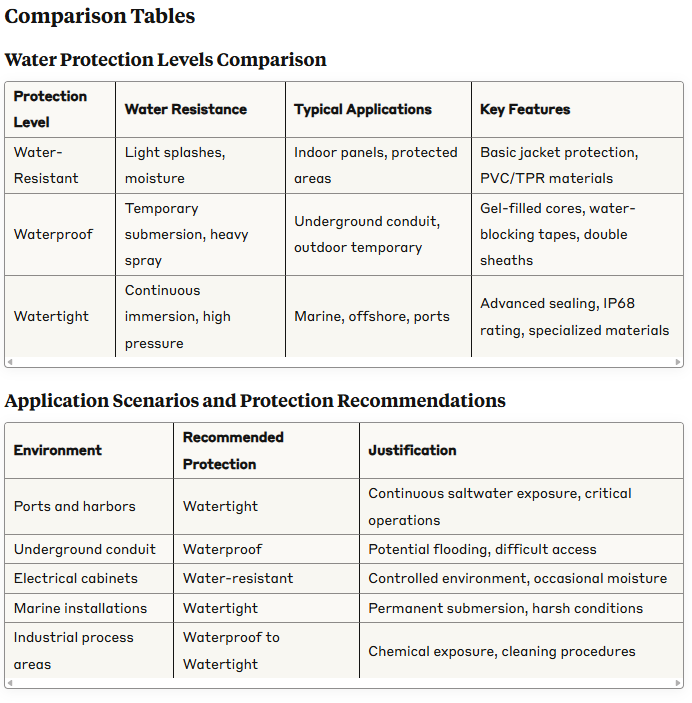

How to Reach Us
Get in Touch
SiteMap
Product Catalogue
Reeling Cable
Festoon Cable
Shore Power Cable




Scan to add us on WeChat
